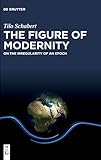The Figure of Modernity : On the Irregularity of an Epoch / Tilo Schabert.
Material type: TextPublisher: Berlin ; Boston : De Gruyter, [2020]Description: 1 online resource (XXXII, 181 p.)Content type:
TextPublisher: Berlin ; Boston : De Gruyter, [2020]Description: 1 online resource (XXXII, 181 p.)Content type: - 9783110671704
- 9783110671872
- 9783110671735
- MLCM 2022/40912 (C)
- online - DeGruyter
- Issued also in print.
| Item type | Current library | Call number | URL | Status | Notes | Barcode | |
|---|---|---|---|---|---|---|---|
 eBook
eBook
|
Biblioteca "Angelicum" Pont. Univ. S.Tommaso d'Aquino Nuvola online | online - DeGruyter (Browse shelf(Opens below)) | Online access | Not for loan (Accesso limitato) | Accesso per gli utenti autorizzati / Access for authorized users | (dgr)9783110671735 |
Browsing Biblioteca "Angelicum" Pont. Univ. S.Tommaso d'Aquino shelves, Shelving location: Nuvola online Close shelf browser (Hides shelf browser)
Frontmatter -- Acknowledgments -- Contents -- Foreword -- Prolegomenon -- Chapter 1. The Floundering God -- Chapter 2. What is Modernity? -- Chapter 3. Discourse On Method -- Chapter 4. The Heritage of the Renaissance: Cosmos and Nature -- Chapter 5. The Heritage of the Renaissance: On the Misery and Dignity of the Human Being -- Chapter 6. The Mastery Over Nature -- Chapter 7. The Crisis of Modernity I -- Chapter 8. The Crisis of Modernity II -- Chapter 9. Gestalt in Modernity: The Constitutional Regime -- Index of Names -- Index of Subjects
restricted access online access with authorization star
http://purl.org/coar/access_right/c_16ec
Two words describe a "modern" world: limits and limitless. Traditionally, humans recognized limits of their power. Modernity meant a break. Its protagonists aspired to bring worlds of their imagination into reality. They taught a new anthropology. Humans could ascend to a God-like status. Schabert analyzes the history of the project and its result: a civilization in a perennial crisis. Symptoms of the crisis have been exposed, today mostly in ecological terms. Schabert takes his material from many fields: philosophy, cosmology, natural sciences, literature, social studies, economics, architecture, and political thought. While modernity is endlessly disrupted, a world beyond modernity can be traced, especially in the modern theory of constitutional government. Constitutional governments are formed by limitations within a civilization that is meant to have no limits. What appears to be paradoxical has its own logic, as Baruch Spinoza, John Locke, Montesquieu, John Adams, the Federalist Papers, John Stuart Mill, Walter Bagehot, and Woodrow Wilson have shown. Schabert carefully explicates their constitutional thought. It realized the limits through which modernity holds a promise.
Issued also in print.
Mode of access: Internet via World Wide Web.
In English.
Description based on online resource; title from PDF title page (publisher's Web site, viewed 27. Jan 2023)









